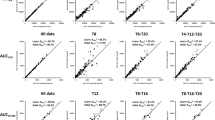Abstract
Quantitative analysis of biochemical parameters is crucial for a correct diagnosis and prognosis of patients subject to acute myocardial infarction (AMI). In order to achieve a quantitative understanding of the dynamics of cardiac biomarkers, we have developed a mathematical model that can be exploited to extrapolate the release curve of cardiac troponin T (cTnT) into the plasma from few experimental acquisitions. The present work introduces a novel approach, based on the cTnT-release model, aimed at the identification of the infarct onset time. Indeed, in spite of the clinical importance of such information, in many cases, it is not easy to establish the exact time of occurrence of the ischemic event. We show that using a model-based optimization approach, the infarct onset time can be reliably estimated using the cTnT concentration acquisitions taken in the first few hours post-AMI. The assessment of the proposed approach is conducted on an experimental dataset, in which the infarct has been artificially induced and, therefore, the onset time is exactly known. In particular, the effectiveness of the devised estimation algorithm has been tested under several scenarios, with the first cTnT acquisition taken up to 12 h after AMI. Altogether, the proposed model-based approach provides a useful tool to help the clinicians in the quantitative estimation of important clinical parameters from the release curves of the cardiac biomarkers.






Similar content being viewed by others
References
Chapman, M. J., K. R. Godfrey, M. J. Chappell, and N. D. Evans. Structural identifiability for a class of non-linear compartmental systems using linear/non-linear splitting and symbolic computation. Math. Biosci. 183:1–14, 2003.
Chis, O., J. R. Banga, and E. Balsa-Canto. Structural identifiability of systems biology models: a critical comparison of methods. PLoS ONE 6:e27755, 2011.
Crank, J. The Mathematics of Diffusion. London: Oxford University Press, 1979.
Ibanez, B., et al. 2017 ESC guidelines for the management of acute myocardial infarction in patients presenting with ST-segment elevation: the Task Force for the Management of Acute Myocardial Infarction in patients Presenting with ST-segment elevation of the European Society of Cardiology (ESC). Eur. Heart J. 39:119–177, 2018.
Liebetrau, C., L. Gaede, J. S. Wolter, J. Homann, A. Meyer, O. Dörr, H. M. Nef, C. Troidl, C. W. Hamm, H. Möllmann, et al. Release kinetics of high-sensitivity cardiac troponins I and T and troponin T upstream open reading frame peptide (TnTuORF) in clinically induced acute myocardial infarction. Biomarkers 22:304–310, 2017.
McManus, D. D., J. Gore, J. Yarzebski, F. Spencer, D. Lessard, and R. J. Goldberg. Recent trends in the incidence, treatment, and outcomes of patients with STEMI and NSTEMI. Am. J. Med. 124:40–47, 2011.
Miao, H., X. Xia, A. S. Perelson, and H. Wu. On identifiability of nonlinear ODEmodels and applications in viral dynamics. SIAM Rev. 53:3–39, 2011.
Procopio, A., S. De Rosa, M. R. García, C. Covello, A. Merola, J. Sabatino, A. De Luca, C. Indolfi, F. Amato, and C. Cosentino. Experimental modeling and identification of cardiac biomarkers release in acute myocardial infarction. IEEE Trans. Control Syst. Technol. 28(1):1–13, 2018.
Rodriguez, F. and K. W. Mahaffey. Updates to the ACCF/AHA and ESC STEMI and NSTEMI guidelines: putting guidelines into clinical practice. J. Am. Coll. Cardiol. 68:313–321, 2016.
Roffi, M., et al. 2015 ESC guidelines for the management of acute coronary syndromes in patients presenting without persistent ST-segment elevation: Task Force for the Management of Acute Coronary Syndromes in patients presenting without persistent ST-segment elevation of the European Society of Cardiology (ESC). Eur. Heart J. 37:267–315, 2016.
Thygesen, K., J. S. Alpert, A. S. Jaffe, B. R. Chaitman, J. J. Bax, D. A. Morrow, H. D. White, et al. Fourth universal definition of myocardial infarction (2018). J. Am. Coll. Cardiol. 72:2231–2264, 2018.
Villaverde, A. F., A. Barreiro, and A. Papachristodoulou. Structural identifiability of dynamic systems biology models. PLoS Comput. Biol. 12:e1005153, 2016.
Waltz, R., J. Morales, J. Nocedal, and D. Orban. An interior algorithm for nonlinear optimization that combines line search and trust region steps. Math. Program. 107:391–408, 2006.
Acknowledgments
A.P. acknowledges support from Regional Project POR Calabria FESR/FSE 2014-2020.
Conflict of interest
Authors declare they have no conflict of interest.
Author information
Authors and Affiliations
Corresponding author
Additional information
Associate Editor Estefanía Peña oversaw the review of this article.
Publisher's Note
Springer Nature remains neutral with regard to jurisdictional claims in published maps and institutional affiliations.
Rights and permissions
About this article
Cite this article
Procopio, A., De Rosa, S., Covello, C. et al. Estimation of the Acute Myocardial Infarction Onset Time based on Time-Course Acquisitions. Ann Biomed Eng 49, 477–486 (2021). https://doi.org/10.1007/s10439-020-02568-z
Received:
Accepted:
Published:
Issue Date:
DOI: https://doi.org/10.1007/s10439-020-02568-z




